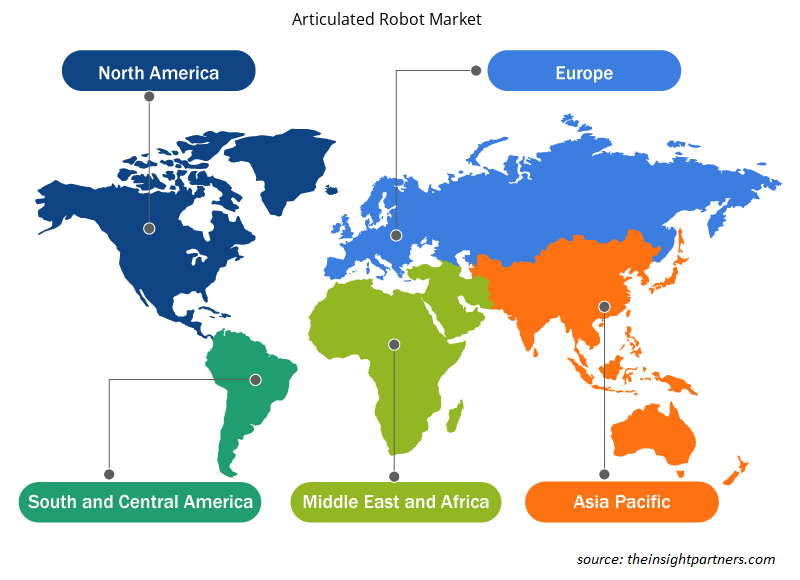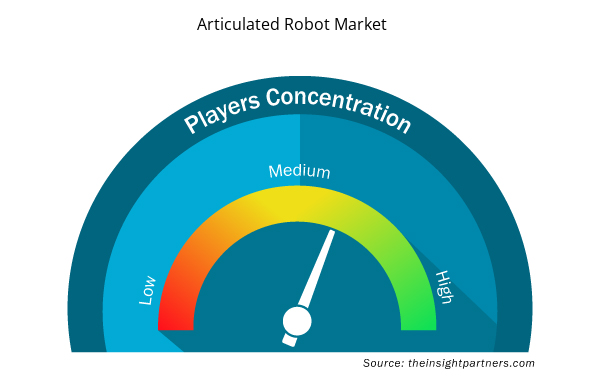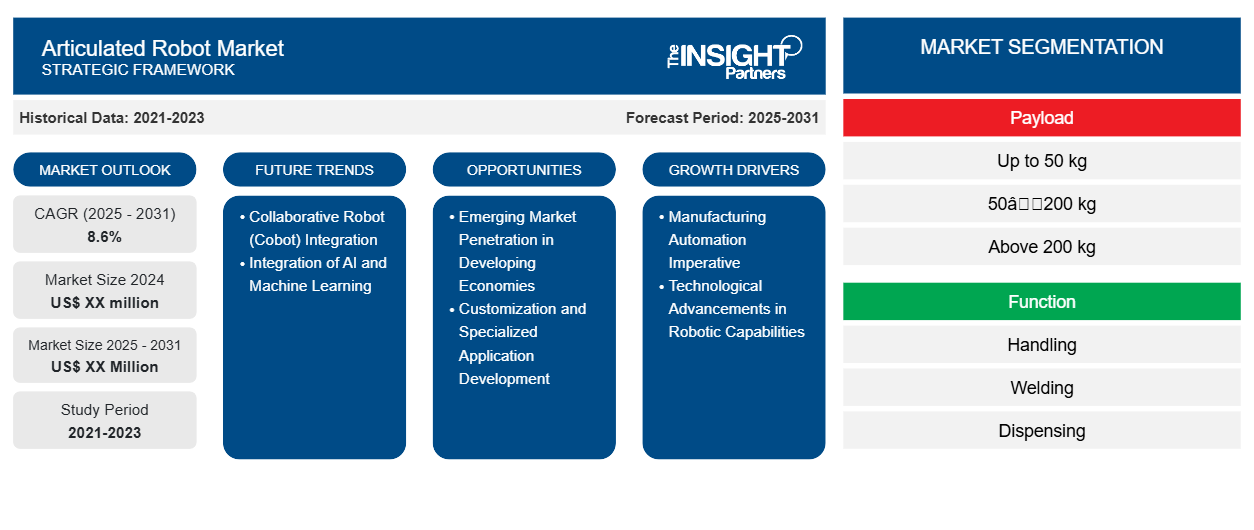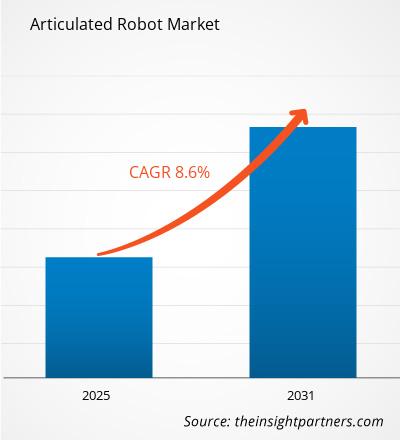Se espera que el mercado de robots articulados registre una CAGR del 8,6 % entre 2024 y 2031, con un tamaño de mercado que se expandirá de US$ XX millones en 2024 a US$ XX millones en 2031.
El informe está segmentado por carga útil (hasta 50 kg, 50-200 kg, más de 200 kg); función (manipulación, soldadura, dispensación, ensamblaje, procesamiento, otros); industria (automotriz, eléctrica y electrónica, metal y maquinaria, alimentos y bebidas, ingeniería de precisión y óptica, productos farmacéuticos y cosméticos, otros). El análisis global se desglosa aún más a nivel regional y por países principales. El informe ofrece el valor en USD para el análisis y los segmentos anteriores.
Propósito del Informe
El informe Articulated Robot Market de The Insight Partners tiene como objetivo describir el panorama actual y el crecimiento futuro, los principales factores impulsores, los desafíos y las oportunidades. Esto proporcionará información a diversas partes interesadas del negocio, como:
- Proveedores/fabricantes de tecnología: Para comprender la dinámica cambiante del mercado y conocer las oportunidades potenciales de crecimiento, lo que les permitirá tomar decisiones estratégicas informadas.
- Inversionistas: Realizar un análisis exhaustivo de tendencias sobre la tasa de crecimiento del mercado, las proyecciones financieras del mercado y las oportunidades que existen en toda la cadena de valor.
- Órganos reguladores: Regular las políticas y vigilar las actividades del mercado con el objetivo de minimizar los abusos, preservar la confianza de los inversores y defender la integridad y la estabilidad del mercado.
Segmentación del mercado de robots articulados
Carga útil
- Hasta 50 kg
- 50-200 kilos
- Más de 200 kg
Función
- Manejo
- Soldadura
- Dispensación
- Asamblea
- Tratamiento
- Otros
Industria
- Automotor
- Electricidad y electrónica
- Metal y Maquinaria
- Alimentos y bebidas
- Ingeniería de precisión y óptica
- Productos farmacéuticos y cosméticos
- Otros
Geografía
- América del norte
- Europa
- Asia-Pacífico
- América del Sur y Central
- Oriente Medio y África
Personalice este informe según sus necesidades
Obtendrá personalización en cualquier informe, sin cargo, incluidas partes de este informe o análisis a nivel de país, paquete de datos de Excel, así como también grandes ofertas y descuentos para empresas emergentes y universidades.
- Obtenga las principales tendencias clave del mercado de este informe.Esta muestra GRATUITA incluirá análisis de datos, desde tendencias del mercado hasta estimaciones y pronósticos.
Factores impulsores del crecimiento del mercado de robots articulados
- La automatización de la fabricación es un imperativo: la búsqueda incesante de la eficiencia operativa y la reducción de costos está impulsando a los fabricantes a integrar robots articulados. Estas sofisticadas máquinas ofrecen una precisión sin precedentes, un rendimiento constante y la capacidad de funcionar las 24 horas del día, los 7 días de la semana, lo que permite a las empresas optimizar los procesos de producción, reducir los errores humanos y mantener una ventaja competitiva en mercados globales cada vez más exigentes.
- Avances tecnológicos en las capacidades robóticas: los avances revolucionarios en inteligencia artificial, aprendizaje automático y tecnologías de sensores están mejorando exponencialmente la adaptabilidad, las capacidades de aprendizaje y el potencial colaborativo de los robots articulados. Estas innovaciones permiten una ejecución de tareas más compleja, una mejor interacción entre humanos y robots y una gama de aplicaciones ampliada en diversos sectores industriales y no industriales.
Tendencias futuras del mercado de robots articulados
- Integración de robots colaborativos (cobots): la creciente tendencia de los robots colaborativos representa un cambio de paradigma en la implementación de la robótica, que pone énfasis en la interacción perfecta entre humanos y robots. Los robots articulados se diseñan cada vez más con funciones de seguridad avanzadas, interfaces de programación intuitivas y capacidades de implementación flexibles, lo que transforma los entornos de fabricación tradicionales en espacios de trabajo adaptativos e inteligentes que priorizan tanto la productividad como la seguridad de los trabajadores.
- Integración de IA y aprendizaje automático: existe una tendencia creciente a integrar la inteligencia artificial (IA) y el aprendizaje automático en robots articulados, lo que les permite aprender, adaptarse y mejorar su rendimiento con el tiempo. Esta tendencia mejora la capacidad de los robots para manejar tareas complejas y dinámicas de forma autónoma, lo que mejora la eficiencia operativa y reduce el tiempo de inactividad en diversas industrias.
Oportunidades de mercado para robots articulados
- Penetración de mercados emergentes en economías en desarrollo: las naciones en rápido proceso de industrialización presentan oportunidades de crecimiento sustanciales para los fabricantes de robots articulados. A medida que estas economías modernizan su infraestructura de fabricación, existe una creciente demanda de soluciones robóticas avanzadas en los sectores automotriz, electrónico y de bienes de consumo, lo que crea un potencial de expansión de mercado significativo con menores barreras iniciales para la adopción de tecnología.
- Desarrollo de aplicaciones especializadas y personalizadas: la creciente complejidad de los requisitos de fabricación crea oportunidades lucrativas para el desarrollo de sistemas robóticos articulados altamente especializados. Las soluciones a medida para industrias en las que la precisión es fundamental, como la aeroespacial, los dispositivos médicos y la electrónica avanzada, pueden exigir precios superiores y establecer un liderazgo tecnológico en segmentos de mercado específicos.
Perspectivas regionales del mercado de robots articulados
Los analistas de Insight Partners explicaron en detalle las tendencias y los factores regionales que influyen en el mercado de robots articulados durante el período de pronóstico. Esta sección también analiza los segmentos y la geografía del mercado de robots articulados en América del Norte, Europa, Asia Pacífico, Oriente Medio y África, y América del Sur y Central.

- Obtenga datos regionales específicos para el mercado de robots articulados
Alcance del informe de mercado de robots articulados
| Atributo del informe | Detalles |
|---|---|
| Tamaño del mercado en 2024 | XX millones de dólares estadounidenses |
| Tamaño del mercado en 2031 | US$ XX millones |
| Tasa de crecimiento anual compuesta (CAGR) global (2025-2031) | 8,6% |
| Datos históricos | 2021-2023 |
| Período de pronóstico | 2025-2031 |
| Segmentos cubiertos | Por carga útil
|
| Regiones y países cubiertos | América del norte
|
| Líderes del mercado y perfiles de empresas clave |
|
Densidad de actores del mercado de robots articulados: comprensión de su impacto en la dinámica empresarial
El mercado de robots articulados está creciendo rápidamente, impulsado por la creciente demanda de los usuarios finales debido a factores como la evolución de las preferencias de los consumidores, los avances tecnológicos y una mayor conciencia de los beneficios del producto. A medida que aumenta la demanda, las empresas amplían sus ofertas, innovan para satisfacer las necesidades de los consumidores y aprovechan las tendencias emergentes, lo que impulsa aún más el crecimiento del mercado.
La densidad de actores del mercado se refiere a la distribución de las empresas o firmas que operan dentro de un mercado o industria en particular. Indica cuántos competidores (actores del mercado) están presentes en un espacio de mercado determinado en relación con su tamaño o valor total de mercado.
Las principales empresas que operan en el mercado de robots articulados son:
- Compañía: ABB Ltd.
- KUKA AG
- Corporación Mitsubishi Electric.
- Corporación FANUC
- Industrias pesadas Kawasaki Ltd.
Descargo de responsabilidad : Las empresas enumeradas anteriormente no están clasificadas en ningún orden particular.

- Obtenga una descripción general de los principales actores clave del mercado de robots articulados
Puntos de venta clave
- Cobertura integral: el informe cubre de manera integral el análisis de productos, servicios, tipos y usuarios finales del mercado de robots articulados, proporcionando un panorama holístico.
- Análisis de expertos: el informe se compila sobre la base de un profundo conocimiento de expertos y analistas de la industria.
- Información actualizada: El informe asegura relevancia comercial debido a su cobertura de información reciente y tendencias de datos.
- Opciones de personalización: este informe se puede personalizar para satisfacer los requisitos específicos del cliente y adaptarse adecuadamente a las estrategias comerciales.
Por lo tanto, el informe de investigación sobre el mercado de robots articulados puede ayudar a abrir camino para descifrar y comprender el escenario de la industria y las perspectivas de crecimiento. Si bien puede haber algunas preocupaciones válidas, los beneficios generales de este informe tienden a superar las desventajas.
- Análisis histórico (2 años), año base, pronóstico (7 años) con CAGR
- Análisis PEST y FODA
- Tamaño del mercado Valor/volumen: global, regional, nacional
- Industria y panorama competitivo
- Conjunto de datos de Excel


- Virtual Pipeline Systems Market
- Small Molecule Drug Discovery Market
- Print Management Software Market
- Employment Screening Services Market
- Data Center Cooling Market
- Medical Second Opinion Market
- Sterilization Services Market
- Lyophilization Services for Biopharmaceuticals Market
- Hair Extensions Market
- Electronic Data Interchange Market

Report Coverage
Revenue forecast, Company Analysis, Industry landscape, Growth factors, and Trends

Segment Covered
This text is related
to segments covered.

Regional Scope
North America, Europe, Asia Pacific, Middle East & Africa, South & Central America

Country Scope
This text is related
to country scope.
Preguntas frecuentes
Some of the customization options available based on the request are an additional 3-5 company profiles and country-specific analysis of 3-5 countries of your choice. Customizations are to be requested/discussed before making final order confirmation# as our team would review the same and check the feasibility
The report can be delivered in PDF/PPT format; we can also share excel dataset based on the request
Collaborative robot (cobot) integration is anticipated to play a significant role in the global articulated robot market in the coming years
Emerging market penetration in developing economies and customization and specialized application development are the major factors driving the articulated robot market
The Articulated Robot Market is estimated to witness a CAGR of 8.6% from 2023 to 2031
Trends and growth analysis reports related to Electronics and Semiconductor : READ MORE..
1. ABB Ltd.
2. KUKA AG
3. Mitsubishi Electric Corp.
4. FANUC Corporation
5. Kawasaki Heavy Industries Ltd.
6. DENSO WAVE INCORPORATED
7. Omron Adept Technology, Inc.
8. Nachi-Fujikoshi Corp
9. Yaskawa Electric Corporation
10. Seiko Epson Corporation
The Insight Partners performs research in 4 major stages: Data Collection & Secondary Research, Primary Research, Data Analysis and Data Triangulation & Final Review.
- Data Collection and Secondary Research:
As a market research and consulting firm operating from a decade, we have published and advised several client across the globe. First step for any study will start with an assessment of currently available data and insights from existing reports. Further, historical and current market information is collected from Investor Presentations, Annual Reports, SEC Filings, etc., and other information related to company’s performance and market positioning are gathered from Paid Databases (Factiva, Hoovers, and Reuters) and various other publications available in public domain.
Several associations trade associates, technical forums, institutes, societies and organization are accessed to gain technical as well as market related insights through their publications such as research papers, blogs and press releases related to the studies are referred to get cues about the market. Further, white papers, journals, magazines, and other news articles published in last 3 years are scrutinized and analyzed to understand the current market trends.
- Primary Research:
The primarily interview analysis comprise of data obtained from industry participants interview and answers to survey questions gathered by in-house primary team.
For primary research, interviews are conducted with industry experts/CEOs/Marketing Managers/VPs/Subject Matter Experts from both demand and supply side to get a 360-degree view of the market. The primary team conducts several interviews based on the complexity of the markets to understand the various market trends and dynamics which makes research more credible and precise.
A typical research interview fulfils the following functions:
- Provides first-hand information on the market size, market trends, growth trends, competitive landscape, and outlook
- Validates and strengthens in-house secondary research findings
- Develops the analysis team’s expertise and market understanding
Primary research involves email interactions and telephone interviews for each market, category, segment, and sub-segment across geographies. The participants who typically take part in such a process include, but are not limited to:
- Industry participants: VPs, business development managers, market intelligence managers and national sales managers
- Outside experts: Valuation experts, research analysts and key opinion leaders specializing in the electronics and semiconductor industry.
Below is the breakup of our primary respondents by company, designation, and region:

Once we receive the confirmation from primary research sources or primary respondents, we finalize the base year market estimation and forecast the data as per the macroeconomic and microeconomic factors assessed during data collection.
- Data Analysis:
Once data is validated through both secondary as well as primary respondents, we finalize the market estimations by hypothesis formulation and factor analysis at regional and country level.
- Macro-Economic Factor Analysis:
We analyse macroeconomic indicators such the gross domestic product (GDP), increase in the demand for goods and services across industries, technological advancement, regional economic growth, governmental policies, the influence of COVID-19, PEST analysis, and other aspects. This analysis aids in setting benchmarks for various nations/regions and approximating market splits. Additionally, the general trend of the aforementioned components aid in determining the market's development possibilities.
- Country Level Data:
Various factors that are especially aligned to the country are taken into account to determine the market size for a certain area and country, including the presence of vendors, such as headquarters and offices, the country's GDP, demand patterns, and industry growth. To comprehend the market dynamics for the nation, a number of growth variables, inhibitors, application areas, and current market trends are researched. The aforementioned elements aid in determining the country's overall market's growth potential.
- Company Profile:
The “Table of Contents” is formulated by listing and analyzing more than 25 - 30 companies operating in the market ecosystem across geographies. However, we profile only 10 companies as a standard practice in our syndicate reports. These 10 companies comprise leading, emerging, and regional players. Nonetheless, our analysis is not restricted to the 10 listed companies, we also analyze other companies present in the market to develop a holistic view and understand the prevailing trends. The “Company Profiles” section in the report covers key facts, business description, products & services, financial information, SWOT analysis, and key developments. The financial information presented is extracted from the annual reports and official documents of the publicly listed companies. Upon collecting the information for the sections of respective companies, we verify them via various primary sources and then compile the data in respective company profiles. The company level information helps us in deriving the base number as well as in forecasting the market size.
- Developing Base Number:
Aggregation of sales statistics (2020-2022) and macro-economic factor, and other secondary and primary research insights are utilized to arrive at base number and related market shares for 2022. The data gaps are identified in this step and relevant market data is analyzed, collected from paid primary interviews or databases. On finalizing the base year market size, forecasts are developed on the basis of macro-economic, industry and market growth factors and company level analysis.
- Data Triangulation and Final Review:
The market findings and base year market size calculations are validated from supply as well as demand side. Demand side validations are based on macro-economic factor analysis and benchmarks for respective regions and countries. In case of supply side validations, revenues of major companies are estimated (in case not available) based on industry benchmark, approximate number of employees, product portfolio, and primary interviews revenues are gathered. Further revenue from target product/service segment is assessed to avoid overshooting of market statistics. In case of heavy deviations between supply and demand side values, all thes steps are repeated to achieve synchronization.
We follow an iterative model, wherein we share our research findings with Subject Matter Experts (SME’s) and Key Opinion Leaders (KOLs) until consensus view of the market is not formulated – this model negates any drastic deviation in the opinions of experts. Only validated and universally acceptable research findings are quoted in our reports.
We have important check points that we use to validate our research findings – which we call – data triangulation, where we validate the information, we generate from secondary sources with primary interviews and then we re-validate with our internal data bases and Subject matter experts. This comprehensive model enables us to deliver high quality, reliable data in shortest possible time.


 Obtenga una muestra gratuita de este informe
Obtenga una muestra gratuita de este informe